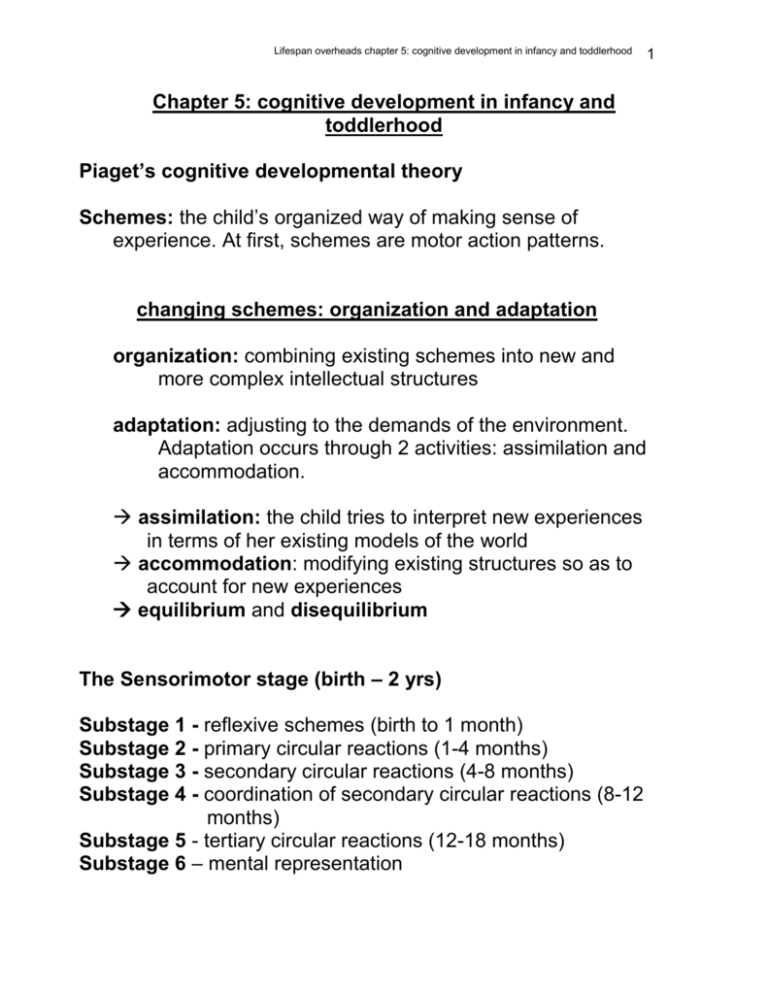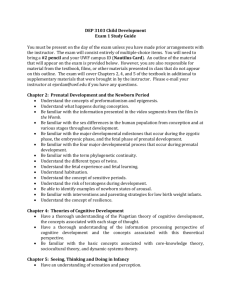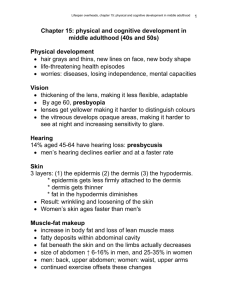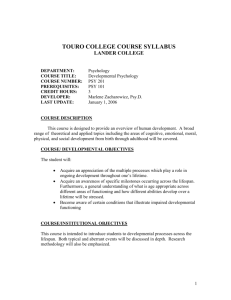Chapter 5 - Monroe Community College
advertisement

Lifespan overheads chapter 5: cognitive development in infancy and toddlerhood Chapter 5: cognitive development in infancy and toddlerhood Piaget’s cognitive developmental theory Schemes: the child’s organized way of making sense of experience. At first, schemes are motor action patterns. changing schemes: organization and adaptation organization: combining existing schemes into new and more complex intellectual structures adaptation: adjusting to the demands of the environment. Adaptation occurs through 2 activities: assimilation and accommodation. assimilation: the child tries to interpret new experiences in terms of her existing models of the world accommodation: modifying existing structures so as to account for new experiences equilibrium and disequilibrium The Sensorimotor stage (birth – 2 yrs) Substage 1 - reflexive schemes (birth to 1 month) Substage 2 - primary circular reactions (1-4 months) Substage 3 - secondary circular reactions (4-8 months) Substage 4 - coordination of secondary circular reactions (8-12 months) Substage 5 - tertiary circular reactions (12-18 months) Substage 6 – mental representation 1 Lifespan overheads chapter 5: cognitive development in infancy and toddlerhood Recent research on sensorimotor development there is evidence that infants understand object permanence as early as 3 ½ months of age! a grasp of the basic regularities of the physical world is present within the first few months deferred imitation is present as early as 6 weeks of age At the end of the 2nd year, toddlers can imitate actions an adult tried to do but didn’t do successfully The Information Processing View (1) Sensory register (2) Working Memory (a.k.a. Short-Term Memory) (3) Long-Term Memory Attention: between 1 and 2 months of age, infants explore objects and patterns more thoroughly get better at managing attention, taking in information more quickly newborns take about 3-4 minutes to habituate to a novel visual stimulus. But by 4-5 months, infants require as little as 5 to 10 seconds to take in a complex visual stimulus capacity for sustained attention improves with age 2 Lifespan overheads chapter 5: cognitive development in infancy and toddlerhood 3 Memory: by 3 months infants remember a visual stimulus for 24 hours by the end of their 1st year, they remember it for several days, and in the case of faces, a few weeks the mobile study Categorization: 7 to 12 month olds structure objects into adultlike categories - foods, furniture, birds, mammals, vehicles, kitchen utensils, etc. earliest categories are perceptual by end of 1st year, categories are becoming conceptual in their 2nd year, toddlers are active organizers The Social Context of Early Social Development Lev Vygotsky’s sociocultural theory: emphasizes the social contexts that children are embedded in, and how they affect their cognitive structures by interacting with peers and adults kids come to master activities and think in ways that have meaning for their culture zone of proximal development: a range of tasks that the child cannot yet handle alone but can do with the help of more skilled partners Lifespan overheads chapter 5: cognitive development in infancy and toddlerhood 4 Individual Differences in early mental development Infant intelligence tests: the Bayley Scales of Infant Development (1 month to 3 ½ years): consists of 2 scales (1) the mental scale, which includes turning to a sound, looking for a fallen object, building a tower of cubes, naming pictures (2) the motor scale, assessing gross and fine skills like grasping, sitting, drinking from a cup, jumping computing intelligence scores (IQs): normal or bell curve norms: standards against which future test takers can be compared. 100 is average; 115 is at the 84th%ile; 130 is at the 98th %ile; 85 is at the 16th %ile; 70 is at the 2nd %ile many infant tests do not predict later intelligence well DQs (developmental quotients) instead of IQs One exception: if the baby is a very low scorer, this does predict low scores later on the information processing view of infant intelligence: speed of habituation & dishabituation to visual stimuli are the best available predictors of intelligence from early childhood into adolescence Lifespan overheads chapter 5: cognitive development in infancy and toddlerhood 5 Early environment and mental development home environment: the Home Observation for Measurement of the Environment (HOME) emotional and verbal responsiveness of the parent to the child acceptance of the child organization of the physical environment appropriate play materials parental involvement with the child variety in daily stimulation of the child. family living conditions predict childrens’ IQ beyond the contribution of parental IQ Infant and Toddler child care: infants and young kids exposed to poor child care, regardless of their own SES, score lower on cognitive and social skills high-quality child care is associated with cognitive, emotional, and social competence in middle childhood and adolescence children most likely to have poor child care are those from low-income and poverty-stricken families Early Intervention for at-risk infants and toddlers Children of poverty tend to show a gradual decline in IQ scores, and achieve poorly when they reach school age. Interventions: childcare/preschool programs with educational, nutritional, and health services home-based interventions that teach the parents how to stimulate the child's development Lifespan overheads chapter 5: cognitive development in infancy and toddlerhood 6 The more intense the intervention, the greater childrens’ later cognitive and academic performance e.g. the California Abecedarian Project of the 1970s: early intervention had a large and lasting impact Language Development kids say their first word around 12 months old once words appear, language develops rapidly between 1 ½ and 2 years, toddlers combine two words by age 6, they have a vocabulary of about 10 000 words, use elaborate sentences, are skilled conversationalists Theories of language development: The behaviourist perspective: imitation and reinforcement are behind the learning of language Skinner (1957): children learn to speak because they are reinforced for it. We teach language by reinforcing successive approximations of grammatical speech. Problems with the empiricist viewpoint: a mother’s approval or disapproval depends on the semantics of what the child says not it’s grammatical correctness. a lot of first statements are things that adults and older kids never say! Lifespan overheads chapter 5: cognitive development in infancy and toddlerhood 7 The Nativist Perspective: Noam Chomsky : the structure of language is too complex to be taught by parents or discovered through trial and error. language acquisition device (LAD): an innate linguistic processor activated by verbal input language acquisition is natural and almost automatic, as long as kids are exposed to linguistic data. Support for this view: - kids reach the same linguistic milestones at the same age - language is species-specific - we are “wired” to understand language. - sensitive period: people who acquire a language after puberty have to work a lot harder to do so, and are likely to have a “foreign” accent when the speak it. - children who were raised past puberty without exposure to language cannot learn langauge in any comprehensive way Problems with the Nativist approach: - a lot of people question the existence of a LAD - some adults DO learn new languages and speak without an accent. - how does an inborn language processor work? They never say. The Interactionist Perspective: - kids are biologically prepared to learn language, but there is an interrelationship between maturation and the linguistic environment the kids are in. Lifespan overheads chapter 5: cognitive development in infancy and toddlerhood 8 Getting ready to talk: cooing (2 montsh) and babbling (4 months) communicating: 3-4 months, the baby starts turn-taking end of 1st year, use preverbal gestures to communicate First words: usually refer to important people, objects that move, familiar actions, or outcomes of familiar actions by the end of the 2nd year, label emotions with words like “happy, “sad”, and “mad”. Underextension and overextension The 2-word utterance phase between 18 and 24 months, a spurt in vocabulary growth takes place - kids will learn as many as 20 new words a week! When vocabulary approaches 200 words, kids start combining 2 words: telegraphic speech Individual and Cultural Differences girls are slightly ahead of boys in early vocabulary growth the more words caregivers use, the more toddlers will pick up the personality of the child is important too Child-directed speech (CDS): a form of language made up of short sentences with high-pitched, exaggerated expression and very clear pronunciation, often with repetition. - from birth, children prefer to listen to CDS over other kinds of adult talk - promotes language learning in many ways: turntaking, zone of proximal development Lifespan overheads chapter 5: cognitive development in infancy and toddlerhood Milestones of language development in the 1st 2 years: 2 months: cooing 4 months on: joint attention, babbling 7 months on: babbling includes sounds of mature spoken languages 6-14 months: turn-taking 8-12 months: preverbal gestures 18-24 months: vocabulary expands to about 200 words 20-26 months: two-word sentences 9








